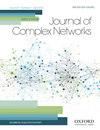A generating-function approach to modelling complex contagion on clustered networks with multi-type branching processes
IF 1.5
4区 数学
Q2 MATHEMATICS, INTERDISCIPLINARY APPLICATIONS
引用次数: 2
Abstract
Abstract Understanding cascading processes on complex network topologies is paramount for modelling how diseases, information, fake news and other media spread. In this article, we extend the multi-type branching process method developed in Keating et al., (2022), which relies on networks having homogenous node properties, to a more general class of clustered networks. Using a model of socially inspired complex contagion we obtain results, not just for the average behaviour of the cascades but for full distributions of the cascade properties. We introduce a new method for the inversion of probability generating functions to recover their underlying probability distributions; this derivation naturally extends to higher dimensions. This inversion technique is used along with the multi-type branching process to obtain univariate and bivariate distributions of cascade properties. Finally, using clique-cover methods, we apply the methodology to synthetic and real-world networks and compare the theoretical distribution of cascade sizes with the results of extensive numerical simulations.具有多类型分支过程的群集网络上复杂传染模型的生成函数方法
理解复杂网络拓扑上的级联过程对于建模疾病、信息、假新闻和其他媒体如何传播至关重要。在本文中,我们将Keating等人(2022)开发的多类型分支过程方法(依赖于具有同质节点属性的网络)扩展到更一般的聚类网络。利用社会激发的复杂传染模型,我们不仅得到了级联的平均行为,而且得到了级联性质的完整分布。本文介绍了一种新的概率生成函数的反演方法,以恢复其潜在的概率分布;这个推导自然地扩展到更高的维度。该反演技术与多类型分支过程相结合,得到了级联性质的单变量和双变量分布。最后,利用团盖方法,我们将该方法应用于合成和现实世界的网络,并将级联大小的理论分布与广泛的数值模拟结果进行了比较。
本文章由计算机程序翻译,如有差异,请以英文原文为准。
求助全文
约1分钟内获得全文
求助全文
来源期刊

Journal of complex networks
MATHEMATICS, INTERDISCIPLINARY APPLICATIONS-
CiteScore
4.20
自引率
9.50%
发文量
40
期刊介绍:
Journal of Complex Networks publishes original articles and reviews with a significant contribution to the analysis and understanding of complex networks and its applications in diverse fields. Complex networks are loosely defined as networks with nontrivial topology and dynamics, which appear as the skeletons of complex systems in the real-world. The journal covers everything from the basic mathematical, physical and computational principles needed for studying complex networks to their applications leading to predictive models in molecular, biological, ecological, informational, engineering, social, technological and other systems. It includes, but is not limited to, the following topics: - Mathematical and numerical analysis of networks - Network theory and computer sciences - Structural analysis of networks - Dynamics on networks - Physical models on networks - Networks and epidemiology - Social, socio-economic and political networks - Ecological networks - Technological and infrastructural networks - Brain and tissue networks - Biological and molecular networks - Spatial networks - Techno-social networks i.e. online social networks, social networking sites, social media - Other applications of networks - Evolving networks - Multilayer networks - Game theory on networks - Biomedicine related networks - Animal social networks - Climate networks - Cognitive, language and informational network
 求助内容:
求助内容: 应助结果提醒方式:
应助结果提醒方式:


